On October 21, Japan broke new ground in its political history as Sanae Takaichi became its first female prime minister.
Her rise to the premiership followed her victory in the Liberal Democratic Party (LDP) presidential election on October 4, which set the stage for a major political realignment. On October 10, political party Komeito ended its 26-year partnership with the LDP, citing disagreements over political funding transparency and unease with Takaichi’s conservative stance. Ten days later, the LDP concluded an extra-cabinet confidence-and-supply agreement with Nippon Ishin no Kai (Japan Innovation Party). The new LDP–Ishin framework marks a shift from the LDP–Komeito era of moderation toward a more security-focused and reform-oriented agenda.
Domestically, the 219th Extraordinary Diet Session, running until mid-December, will serve as the administration’s first major test, with debate centered on the FY2025 supplementary budget, expected to pass by the end of the year. Abroad, at the end of October, Takaichi faces an intense round of summit diplomacy—attending the ASEAN meetings in Malaysia, hosting US President Donald Trump in Tokyo, and participating in the APEC Leaders’ Meeting in South Korea—which will test her ability to balance assertive security priorities with pragmatic alliance management.
For businesses, the policy landscape is shifting toward state-backed innovation and strategic autonomy. Healthcare will benefit from early fiscal support and ongoing reimbursement reform; the AI sector is emerging as a national strategic priority anchored in economic security; and the defense industry is opening to new dual-use and technology partnerships under expanded spending. Companies should position themselves as strategic partners in this policy transformation—aligning innovation and investment with government priorities in security, technology, and social resilience to remain competitive in Japan’s evolving industrial ecosystem.
The Road to the Takaichi Administration
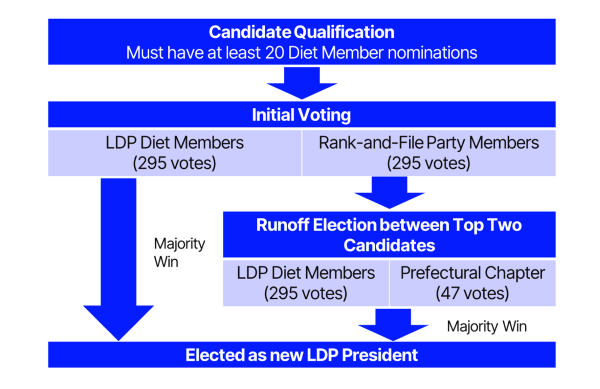 LDP Presidential Election
LDP Presidential Election
The LDP held its leadership vote on October 4, selecting former Economic Security Minister Sanae Takaichi as the party’s 29th president. In the first round, none of the five candidates secured a majority, leading to a runoff between Takaichi and Agriculture Minister Shinjiro Koizumi. Takaichi won the runoff with 185 votes to Koizumi’s 156, securing 54% and clinching the party presidency. This made Takaichi the first woman to lead the LDP in its 70-year history, a milestone widely recognized in Japan and abroad.
Takaichi presented the victory as the beginning of a “new era” for the LDP, highlighting the need to turn public anxiety into hope, keep promises, and call for an “all-hands” effort—"work, work, and work,” even stating she would “discard work–life balance” for now to rebuild.
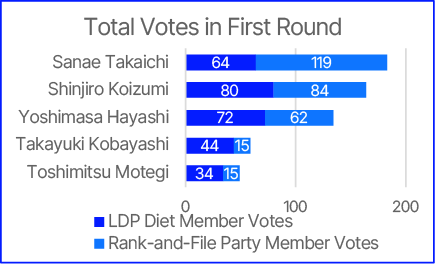
What drove Takaichi’s win?
Analysts point to her strong base of support among LDP rank-and-file members and the backing of party heavyweight Taro Aso. In the first round, Takaichi commanded roughly 40% of party members’ votes, outperforming rivals among local LDP chapters. Her widespread appeal to the conservative grassroots, amplified by an active social media campaign, helped offset more divided support for moderate candidates.
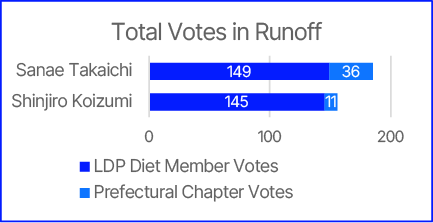
Meanwhile, former Prime Minister Aso, leading the LDP’s only remaining faction, threw his influence behind Takaichi. Aso’s maneuvering rallied Diet members from the camps of eliminated contenders, such as former Foreign Minister Toshimitsu Motegi and ex-Economic Security Minister Takayuki Kobayashi, to support Takaichi in the runoff.
Commentators noted that Aso’s endorsement was critical to her victory, underscoring that old-guard factional politics, while diminished, still mattered in the final stretch.
Post Party Vote and Pre-PM Designation Developments
Breaking a 26-Year Alliance: Komeito’s Coalition Exit
Takaichi’s election immediately triggered high-stakes coalition politics. The LDP had been in a coalition with the Komeito party since 1999, but that partnership was thrown into doubt by Takaichi’s ascent. Komeito, a centrist party supported by the lay Buddhist organization Soka Gakkai, harbored deep reservations about Takaichi’s hardline views. Just days after the LDP vote, on October 10, Komeito leader Tetsuo Saitō informed Takaichi that his party would leave the ruling coalition, ending a 26-year alliance. Komeito cited policy rifts, accusing the LDP of failing to tighten political funding rules after a recent money-for-politics scandal and being “unnerved by Takaichi’s ultraconservative positions,” including her history of hawkish remarks on China and advocacy of controversial visits to the Yasukuni Shrine. While Komeito and Takaichi found common ground on some issues, they ultimately could not agree on political funding―Komeito wanted a ban on corporate and organizational donations, which many in the LDP resisted. This impasse prompted Komeito’s withdrawal, depriving the LDP of its lower house majority and plunging Japanese politics into uncertainty. Sensing an opportunity, the opposition floated the idea of a “rainbow coalition” to block Takaichi. For a brief period, opposition leaders discussed uniting behind a single consensus candidate for prime minister who might peel off enough votes in the hung parliament. However, this effort never solidified as the prospect of disparate parties from left to right forming a government was remote, and time was short before the Diet’s special session.
A Rightward Shift: New LDP–Ishin Cooperation Framework and Its Policy Agenda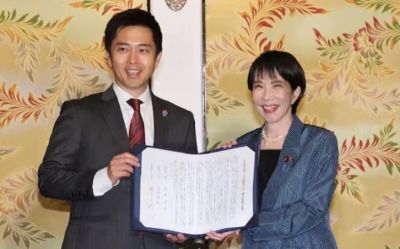
Instead, Takaichi turned to a rising potential ally on the right: Nippon Ishin no Kai (Japan Innovation Party, “Ishin”). Ishin is an Osaka-based conservative/libertarian party that has been an opposition force but shares many policy objectives with Takaichi. In a last-minute deal on October 20, LDP President Takaichi and Ishin co-leader Hirofumi Yoshimura reached a confidence and supply agreement, signing a formal accord in front of the press that evening. Under this arrangement—known in Japan as “kakugai kyōryoku” (extra-cabinet cooperation)—Ishin will support the administration on key votes without joining the Cabinet, effectively replacing Komeito as the LDP’s parliamentary partner while retaining some independence.
The new LDP–Ishin cooperation framework represents a significant shift in Japan’s governing alignment and policy priorities. This is the first time the LDP is co-governing with the Japan Innovation Party, after decades of partnership with the centrist Komeito. The confidence and supply agreement between LDP and Ishin contains 12 policy points that outline the joint agenda and reflect compromises made to secure Ishin’s support. Broadly, the deal moves the government’s platform toward Ishin’s reformist and nationalist positions, while accommodating some of Takaichi’s longstanding goals. It also pointedly redefines the ideological voice of the ruling bloc: the agreement’s preamble emphasizes “shared national vision” and building an “independent nation,” language that contrasts with the previous LDP-Komeito charters (notably, words like “human rights” and “rule of law”—staples in Komeito-era statements—were omitted this time). The cooperation framework under Takaichi and Ishin is doubling down on state-centric and security-oriented principles, unconstrained by Komeito’s moderating influence.
Key elements of the LDP–Ishin 12-point agreement include (in this section the term “coalition” will be used to refer collectively to the two parties operating under a confidence-and-supply arrangement):
- “Secondary Capital” Plan: At Ishin’s urging, the coalition will explore establishing Osaka as a de facto secondary capital to support Tokyo. A joint LDP–Ishin committee will be established during the current Diet session to examine the secondary capital concept, with the goal of passing enabling legislation by the 2026 regular Diet session.
- Social Security Reforms: The partners agree to pursue reforms to Japan’s pension and social insurance systems, including reducing social insurance premiums to ease burdens on working generations. They also plan to promote administrative efficiencies in the social security system. (Takaichi and Ishin both seek to address public discontent over pension sustainability and high health insurance costs.)
- Political and Administrative Reforms: The coalition vows to cut the number of Diet members by 10%. They intend to submit a bill in the 2025 extraordinary session to reduce the number of seats and seek its passage. They also agreed to continue discussions on banning corporate and organizational political donations, with a promise to conclude Takaichi's term as LDP president.
- Tax Relief: In response to cost-of-living pressures, the coalition will consider a temporary suspension of the consumption tax (VAT) on food items for a period of two years. Ishin had called for a zero percent consumption tax on food to ease the burden on households. The agreement does not implement it outright but explicitly lists it as an item for study, signaling a potential targeted tax cut.
- National Security and Defense: In a striking turn, the coalition platform is filled with hawkish security proposals that had been off-limits under Komeito’s influence. Takaichi and Ishin underscore “re-establishing Japan as a self-reliant nation” in security matters. Among the new initiatives:
- Enacting a law to criminalize desecration of the national flag, making it an offense to damage or defile the Hinomaru flag.
- Establishing a foreign intelligence agency or a national information bureau to strengthen Japan’s intelligence-gathering and counter-espionage capabilities.
- Passing an anti-espionage law at an early date, to punish espionage and leaks of state secrets.
- Moving up the scheduled revision of Japan’s three key defense documents and initiating debate on acquiring nuclear-powered submarines for the Maritime Self-Defense Force.
- Removing restrictions on defense equipment exports—eliminating the current “Five Principles” that restrict arms exports and introducing state-owned defense industry facilities (a “national arsenal” concept) to bolster domestic arms production.
- These security measures highlight the new coalition’s alignment on a more assertive defense policy. Analysts note that with Komeito gone, Takaichi’s administration may take a harder line on historical and territorial issues, potentially straining relations with surrounding countries, including China or South Korea, if not managed carefully.
- Social and Immigration Policy: The coalition agreement also reflects Takaichi’s traditionalist social views, albeit with nuanced compromises.
- It explicitly commits to maintaining the principle of “one family, one surname” in the family registry, insinuating that Japan will not legalize separate surnames for married couples, a hot-button social issue. On gender equality and diversity, therefore, the new administration is expected to take a conservative approach.
- The coalition has agreed on tougher stances in immigration: embracing “quantitative management” of foreign worker inflows and considering numeric caps on immigration, as well as tightening regulations on land acquisition by foreigners and foreign capital. This points to a more restrictive immigration policy consistent with Takaichi’s past skepticism toward significant increases in foreign labor.
Overall, the LDP–Ishin pact represents a realignment of Japan’s ruling power toward the right. After years of moderation under LDP-Komeito rule, policies that Komeito had vetoed, from defense expansion to nationalist symbolism, are now on the table. The 26-year LDP–Komeito partnership has collapsed, and with it the moderating influence Komeito exerted. In its place, Takaichi’s government is adopting many of Ishin’s reformist ideas (on government slimming and deregulation) while doubling down on “autonomous defense and sovereignty” as core themes. This ideological shift could redefine Japan’s policy trajectory in the coming years, assuming the new cooperation framework holds together.
Prime Minister Designation Vote 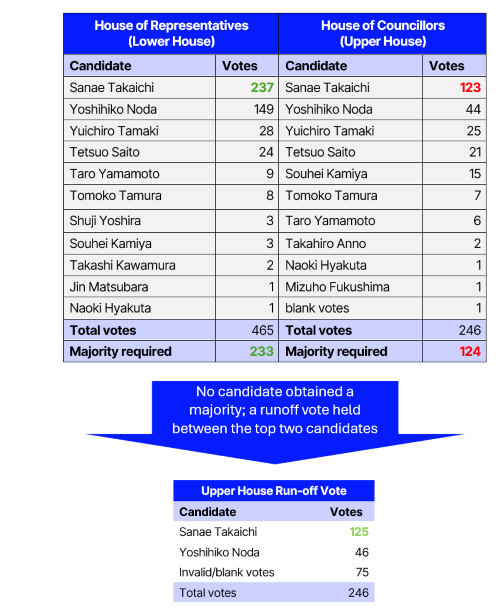
Takaichi was elected Japan’s 104th prime minister in a prime ministerial vote held during the extraordinary Diet session on October 21, following the resignation of former Prime Minister Shigeru Ishiba.
In the House of Representatives, Takaichi secured 237 votes, exceeding the 233 required for a majority. The LDP’s 196 seats, combined with 35 from its partner, the Japan Innovation Party (Ishin), accounted for most of her support, while several independents affiliated with the “Reform Group” also voted in her favor.
In the House of Councillors, Takaichi received 123 votes in the first round—one short of a majority—prompting a runoff. She then won the second round with 125 votes, securing her appointment by both chambers. Opposition parties split their votes, with the Constitutional Democratic Party supporting its leader Yoshihiko Noda, while Komeito, the Democratic Party for the People, and others each backed their own candidates, resulting in a fragmented opposition showing.
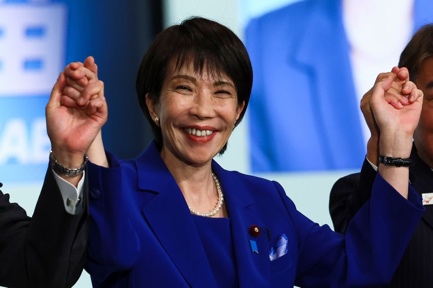 Who is Sanae Takaichi?
Who is Sanae Takaichi?
Born in 1961 in Nara Prefecture, Sanae Takaichi (64) has been a central conservative voice in the Liberal Democratic Party (LDP) for decades. A graduate of Kobe University, she also spent time in the US as a Congressional Fellow in the 1980s. Elected to the House of Representatives in 1993, she has since secured 10 consecutive victories in Nara’s 2nd district.
Takaichi has held multiple cabinet positions, including two terms as Minister for Internal Affairs and Communications. Under the leadership of former Prime Minister Shinzo Abe, she became the first woman to chair the LDP Policy Research Council in 2012. Most recently, she served as Minister of State for Economic Security (2022–2023), overseeing Japan’s technology and supply-chain resilience. A noted security hawk, she advocated for tighter controls on sensitive technologies and foreign land purchases. After previous leadership bids in 2021 and 2024, her victory in 2025 marks the culmination of a long pursuit of party leadership.
Takaichi is a staunch conservative nationalist, closely aligned with Abe’s political legacy. She prioritizes constitutional revision—particularly formalizing the Self-Defense Forces in Article 9—and supports a robust defense posture. Socially, she upholds traditional values, opposing same-sex marriage and female imperial succession.
Economically, she espouses a pragmatic, pro-growth agenda modeled on “Abenomics,” favoring fiscal stimulus and monetary easing under what she calls a “responsible proactive fiscal policy.” She seeks to address demographic decline through family-centered incentives while maintaining fiscal stability.
Takaichi frequently cites Margaret Thatcher as her political role model, aspiring to be Japan’s “Iron Lady.” She emphasizes decisive leadership and national strength, aiming to combine ideological conviction with administrative competence.
Her premiership will test whether a deeply conservative leader can broaden appeal beyond the LDP’s right wing. How she balances assertive nationalism with economic pragmatism and inclusivity will shape both her domestic agenda and Japan’s global posture.
The New Cabinet
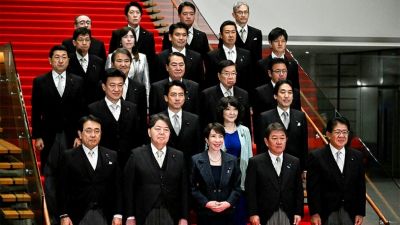 Sanae Takaichi’s new cabinet features a strategic mix of veteran policymakers and younger conservatives in key posts. She tapped Satsuki Katayama (a close ally of the late Shinzo Abe and a fiscal dove) as Finance Minister, making Katayama the first woman ever to hold that position. Veteran lawmaker Toshimitsu Motegi (70) returns as Foreign Minister, and 44-year-old Shinjiro Koizumi (a popular political scion who recently challenged Takaichi for the LDP leadership) becomes Defense Minister. For economic strategy, trade expert Ryosei Akazawa (64) will lead the Ministry of Economy, Trade and Industry (METI). At the same time, Kenichiro Ueno (60) takes charge of Health, Labor and Welfare, and Hisashi Matsumoto (63) heads the Digital Transformation portfolio, tasked with social welfare and digital reform, respectively. In unveiling her team, Takaichi described it as “a cabinet committed to making decisions and progress,” underscoring her pledge to govern boldly and “build a strong Japan.”
Sanae Takaichi’s new cabinet features a strategic mix of veteran policymakers and younger conservatives in key posts. She tapped Satsuki Katayama (a close ally of the late Shinzo Abe and a fiscal dove) as Finance Minister, making Katayama the first woman ever to hold that position. Veteran lawmaker Toshimitsu Motegi (70) returns as Foreign Minister, and 44-year-old Shinjiro Koizumi (a popular political scion who recently challenged Takaichi for the LDP leadership) becomes Defense Minister. For economic strategy, trade expert Ryosei Akazawa (64) will lead the Ministry of Economy, Trade and Industry (METI). At the same time, Kenichiro Ueno (60) takes charge of Health, Labor and Welfare, and Hisashi Matsumoto (63) heads the Digital Transformation portfolio, tasked with social welfare and digital reform, respectively. In unveiling her team, Takaichi described it as “a cabinet committed to making decisions and progress,” underscoring her pledge to govern boldly and “build a strong Japan.”
Key Positions
Position | Name | Profile |
|---|---|---|
| Minister of Finance (MOF) |
Satsuki Katayama (66) | Previously a senior bureaucrat in the finance ministry and veteran LDP lawmaker. She is firmly in the conservative, reform-bureaucratic wing of the LDP. |
| Minister of Foreign Affairs (MOFA) |
Toshimitsu Motegi (70) | Veteran LDP politician, former Minister of METI, former Foreign Minister, former LDP Secretary-General; moderately conservative, with technocratic credentials and strong factional backing. |
| Minister of Defense (MOD) |
Shinjiro Koizumi (44) | Runner-up for LDP President, and son of former Prime Minister Junichirō Koizumi; elected in 2009; prior roles include Environment Minister and, for a short period, Agriculture Minister. |
| Minister of Economics, Trade and Industry (METI) |
Ryosei Akazawa (64) | A pragmatic conservative known for his expertise in economic and infrastructure policy, he served under the Ishiba administration as Minister for Economic Revitalization, leading Japan–US tariff negotiations and promoting. |
| Minister of Health, Labor and Welfare (MHLW) |
Kenichiro Ueno (60) | Former Deputy Finance Minister from Shiga Prefecture and ex-bureaucrat at the Ministry of Home Affairs. A mainstream LDP conservative focused on sustaining Japan’s welfare and pension systems while promoting traditional family policies and administrative reform. |
| Minister for Digital Transformation |
Hisashi Matsumoto (63) | Former medical doctor/trauma surgeon turned politician; prior experience in defense and foreign affairs. As a former physician, Matsumoto aims to accelerate digital transformation in healthcare. |
What's Next?
Parallel tests of leadership will define the opening months of the Takaichi administration, as it implements a complex domestic agenda while launching a high-profile round of diplomacy abroad.
At home
Japan’s 219th Extraordinary Diet Session convened on October 21 for a 58-day term through December 17, marking the first legislative test for the new government. The ruling parties have proposed that Prime Minister Takaichi deliver her policy speech on October 24, followed by party leaders’ questions on November 4 and 5. The debate will center on the FY2025 supplementary budget, designed to fund the government’s new economic stimulus package, and on a bipartisan bill to abolish the provisional gasoline tax rate by year-end.
These deliberations will provide an early indication of how effectively the LDP–Japan Innovation Party cooperation framework can manage fiscal coordination and legislative consensus, particularly amid growing expectations for economic revitalization and social policy reform.
Abroad
Prime Minister Takaichi’s first major diplomatic test will come immediately after the Diet’s opening. From October 26, she will travel to Malaysia to attend the ASEAN-related Summit Meetings.
She will then host US President Donald Trump’s visit to Japan from October 27 to 29. During the visit, Trump will hold an audience with Emperor Naruhito on October 27 and a bilateral summit with Prime Minister Takaichi on October 28, before visiting the US Navy’s Yokosuka Base. The Japan-US Summit Meeting is expected to serve as a pivotal moment in shaping the early tone of the Japan–US alliance, offering both leaders a chance to build personal trust and reaffirm cooperation toward a “Free and Open Indo-Pacific.” Discussions will likely focus on Japan’s evolving defense policy under the Takaichi administration, including its plan to accelerate revisions to the Three Security Documents and advance the JPY 43 trillion (USD 280 billion) defense spending framework ahead of schedule. Takaichi is expected to outline measures to strengthen counterstrike capabilities, expand drone operations, and reinforce cybersecurity, while seeking US understanding for Japan’s more assertive security posture. The two sides are also expected to reaffirm the US–Japan tariff agreement concluded under former Prime Minister Ishiba, signaling continuity in the economic dimension of the alliance.
Following Trump’s visit, Takaichi is expected to travel to South Korea to attend the APEC Leaders’ Meeting.
Policy Implications for Businesses
Market Reaction
The inauguration of Prime Minister Takaichi triggered a broadly positive market response. The Nikkei Stock Average climbed from around 44,000 before the LDP leadership vote to near the 50,000 mark, driven by expectations of expansionary fiscal policy and continued monetary easing—what analysts have called the “Takaichi trade.” Much of this rally reflects symbolic factors: optimism over the new LDP–Japan Innovation Party cooperation framework and enthusiasm surrounding Japan’s first female prime minister. As the initial euphoria fades, investors are turning more cautious, noting that the new administration’s emphasis on fiscal discipline could moderate Takaichi’s more aggressive policy agenda. With limited improvement in real wages or productivity, the market’s strength remains largely nominal, supported by inflation and a weak yen. While the pace of gains may slow, equity valuations are likely to remain high in the near term.
In the bond market, yields have inched higher amid concerns about fiscal expansion. The benchmark 10-year government bond yield rose to around 1.665%, reflecting portfolio adjustments and unease about future debt issuance. Although Prime Minister Takaichi has reaffirmed respect for the Bank of Japan’s independence and ruled out revising the 2013 joint statement, investors are watching for potential divergence within the cooperation framework. The BOJ is expected to maintain its current policy stance at the October meeting, with markets now focused on the upcoming supplementary and FY2025 budgets as key signals of the government’s fiscal direction.
The yen began the new administration’s tenure at around JPY 151 per dollar—a calm continuation of recent depreciation. The currency weakened on expectations that the Takaichi government would pursue reflationary policies and that the BOJ would struggle to secure political backing for near-term rate hikes. Unlike last year’s sharp yen sell-off under the Ishiba administration, this transition has been notably orderly, suggesting market confidence in policy continuity. Some strategists see room for further weakness toward JPY 155 later this year, though risks of reversal remain if US growth slows or dollar weakness resumes.
Overall, the Takaichi administration’s market debut has been marked by high equities, a weak yen, and moderately higher bond yields—a reflection of nominal momentum rather than real economic strength. While investor sentiment remains constructive, the durability of these trends will depend largely on external factors, particularly developments in the US economy and global currency dynamics.
Implications for Key Areas
Healthcare
Prime Minister Takaichi has made healthcare reform an immediate priority, warning that 70% of Japan’s medical institutions are operating at a deficit. The government plans to advance subsidies for hospitals and nursing care facilities ahead of the regular medical service fee revision (shinryo hoshū) to support management and staff compensation. These measures are expected to be incorporated into the FY2025 supplementary budget, which will be deliberated during the extraordinary Diet session through mid-December, with budget approval anticipated by year-end, enabling the early disbursement of funds. With MHLW Minister Ueno focusing on social security sustainability and Digital Minister Matsumoto promoting healthcare digitalization, the policy direction combines short-term stabilization with long-term efficiency and innovation.
For healthcare businesses, early alignment with government priorities will be vital—including participation in reimbursement reform discussions, adopting digital tools that improve operational efficiency, and promoting pharmaceutical innovation.
Artificial Intelligence
Under the Takaichi administration, AI has moved from a technology agenda to a national strategic priority—integral to Japan’s goals of economic revitalization, digital sovereignty, and security resilience. The government is expected to promote domestic AI development and infrastructure, ensuring that critical algorithms, computing capacity, and datasets are produced and governed within Japan. This shift aligns with the administration’s broader focus on economic security and reducing dependency on foreign digital ecosystems.
For the private sector, this creates both opportunity and accountability. Companies across industries—ranging from industrial manufacturing to healthcare and defense—can anticipate expanded public investment and partnership frameworks to scale AI applications that enhance productivity and competitiveness. Yet as AI becomes embedded in public services and critical infrastructure, firms will face stricter transparency, data governance, and ethical-use requirements. Businesses should proactively align their R&D and compliance strategies with national AI policy priorities, positioning themselves as trusted partners in Japan’s pursuit of secure, innovation-led growth.
Defense
Prime Minister Takaichi has placed national defense and economic security at the center of her policy agenda, signaling a rapid acceleration of Japan’s defense buildup. The confidence and supply agreement with the Japan Innovation Party calls for an early revision of the Three Security Documents. It sets the stage for defense spending to rise toward 2% of GDP—a historic shift in Japan’s postwar defense posture. While the debate over fiscal resources will continue, policy direction is clear: greater investment in unmanned systems, missile defense, space and cyber capabilities, and domestic defense production.
For the industry, this marks the expansion of a “national security economy.” Defense and dual-use sectors—including aerospace, shipbuilding, advanced electronics, AI, and semiconductors—can expect new opportunities in procurement, joint R&D, and co-development with allied partners. At the same time, deeper involvement will require stronger compliance, from export control to cybersecurity governance. Companies should align innovation, risk management, and partnership strategies with Japan’s evolving security priorities to remain competitive in this transformed landscape
Materials presented by Edelman’s Public & Government Affairs experts. For additional information, reach out to Yuichi.Kori@edelman.com.









